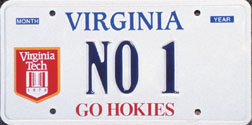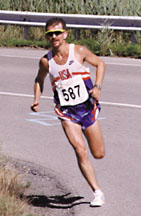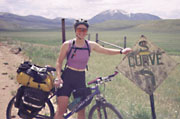-
CONTENTS
Show Us Your Stuff winner
Tech tops Virginia colleges in plate sales
Monogram Club seeks letter winners
Not your ordinary morning jog
National architecture official inspects The Grove
Coniff named acting director of the IBB
Garvin bikes 2,500 miles of the Continental Divide
Kurtin among top multimedia producers
Alumni officially part of the NFL
![]()
 |
Frank D. Straus (chemistry '76) has a reason to smile: he's the winner of Virginia Tech Magazine's Show Us Your Stuff Contest. The "VT" permanently etched on Straus' tooth won us over for its wackiness. Back to Contents
|
Tech tops Virginia colleges in plate sales

It's a fact: Hokies have more spirit. Just ask the Virginia Department of Motor Vehicles. Virginia Tech license plates are the most popular college plates in Virginia. With 21,332 total plate sales, Tech beats runner-up UVa (10,340 sales) by a two-to-one margin. Each Tech plate sale after the first 1,000 nets $15 for university programs like scholarships and tuition assistance for Virginia students. Since the program's inception through fiscal year 1998, sales of Virginia Tech plates have generated $220,260 for the university. DMV forecasts indicate the university may receive as much as $60,000 from sales in the 1999 fiscal year. The plates, which cost $25 in addition to annual registration fees, are available in a university shield version (shown above) and in a university seal version. They can be purchased at any DMV customer service center. In November 1999 the plates will also be available for purchase online at www.dmv.state.va.us.Back to Contents |
Monogram Club seeks letter winners
|
Were you a recipient of a monogram while participating in intercollegiate athletics at Virginia Tech? If so, the Virginia Tech Monogram Club (formerly the Alumni Monogram Club) would like to hear from you. Please contact Terry Strock at 540/231-9156 or strock@vt.edu. Back to Contents
|
 |
Howard Nippert (biology '88, M.S.) finished 39th out of 1,500 runners in the International Amateur Athletic Federation 100K World Championship race in Chavagne, France, in May. Nippert, a member of the USA Ultra Team, was third best among the race's American runners. He ran the course in 7:11:55, averaging less than seven minutes per mile.
The race was a test of will, says Nippert. "I think anyone else would have quit if they felt the way I did, but that wasn't an option. It's never an option when you're wearing a USA uniform." Nippert qualified for the U.S. team by winning two ultra races last year, including the largest ultra distance race in North America, the JFK 50 miler. Back to Contents |
National architecture official inspects The Grove
 |
Robert Boynton (architecture '69) has been elected secretary of the National Council of Architectural Registration Boards. The council is a federation of the architectural registration boards of the 50 states and the District of Columbia as well as four U.S. territories.
Boynton is also president of the Richmond, Va.-based Boynton, Rothschild, Rowland Architects, the firm hired recently to study the condition of The Grove, Virginia Tech's presidential residence. Boynton's report indicates that the 98-year-old building has been well-maintained and needs no major work in preparation for the next president after Paul E. Torgersen's retirement in December. Back to Contents |
Coniff named acting director of the IBB
 |
Brian Coniff (public administration '74) is acting director of the International Broadcasting Bureau (IBB), which consists of the Voice of America, Worldnet Television, and the Office of Cuba Broadcasting (Radio and TV Marti). The bureau provides engineering and transmission support to all U.S.-funded non-military international broadcasts, including Radio Free Europe/
Radio Liberty, Radio Free Asia, and Radio Free Iran. "The idea," says Coniff, "is to provide the people of the world a balanced picture of American values, culture, life, and foreign policy." |
Garvin bikes 2,500 miles of the Continental Divide
 In the summer of 1998, Erin Garvin (health and physical education M.A. '96) and five companions biked the 2,500 miles of the Continental Divide from Montana to New Mexico. Garvin and Sarah Thompson became the first women to complete the entire trail. In the summer of 1998, Erin Garvin (health and physical education M.A. '96) and five companions biked the 2,500 miles of the Continental Divide from Montana to New Mexico. Garvin and Sarah Thompson became the first women to complete the entire trail.
The epic journey took two months, often in extreme weather conditions. In Montana the group cycled through 14 consecutive days of ice and hail. Three-foot snow drifts greeted them at the Wyoming/Idaho border. Garvin suffered frostbite on her toes. The riders reached New Mexico in the middle of a heat wave. They carried four days' worth of food at a time and filtered water from snow and other sources, including stagnant pools of water in the Great Basin desert. A patch of peanut-butter-like mud ruined Garvin's brakes at one point, but she fixed them. "You learn to MacGuyver a lot of things," she says. Back to Contents |
Kurtin among top multimedia producers
 |
AV Video Multimedia Producer magazine has named Matt Kurtin (electrical engineering '93, M.S.) one of the nation's top 100 multimedia producers for 1998. Kurtin received the award for his CD-ROM, The Carolina Nurseries' 1998 Wholesale Catalog and Price List. The catalog, which is distributed to retail nurseries nationwide, is the first of its kind in the wholesale nursery industry and features more than 1,600 items sorted in 24 categories, a recipe book, a history section, and a video about leading nursery professionals.
Kurtin works for Interactive Design and Development (IDD) in Blacksburg, Va. Many of Kurtin's projects at IDD have been oriented toward health and personal improvement: "It's exciting to be working in an area where we're helping people," he says. Back to Contents |
Alumni officially part of the NFL
 The play was about to begin when Ron Phares (civil engineering '65) heard a voice behind him say, "You've got to give us a little help here, old Hokie." Those words came from Bruce Smith (arts and sciences '85), a defensive end for the Buffalo Bills. Buffalo was on offense, needing a good play, and Phares, an NFL official, was standing in front of the Buffalo bench. Of course, Smith did not expect any favoritism, even from an old Hokie, but it was fun to make the connection. The play was about to begin when Ron Phares (civil engineering '65) heard a voice behind him say, "You've got to give us a little help here, old Hokie." Those words came from Bruce Smith (arts and sciences '85), a defensive end for the Buffalo Bills. Buffalo was on offense, needing a good play, and Phares, an NFL official, was standing in front of the Buffalo bench. Of course, Smith did not expect any favoritism, even from an old Hokie, but it was fun to make the connection.
Phares is in his 15th season as an NFL official, and fellow alumnus Scott Dawson (civil engineering '68) is in his fifth season. Phares wears number 10 and works on the sidelines as a line judge. Dawson is an umpire, number 70, standing near the linebackers before the beginning of each play. They work on the same crew during the regular season. Stepping up to football on the level of the NFL after working for years in Division 1 was quite an adjustment for both officials. "The level of concentration is the most I've ever had to have," says Phares. "We're in front of the camera 100 percent of the time. It's the most scrutinized I've ever been." The NFL chooses officials through rigorous tests of skill and judgment, an exhaustive background check, and a psychological profile. The league wants people who can stand up to the pressure of calling games in front of a quarter-billion people, as super bowls can draw that many viewers worldwide. Phares worked Super Bowls XXVII (Dallas vs. Buffalo) and XXIX (San Francisco vs. San Diego). Both men worked playoff games last year. Back to Contents |